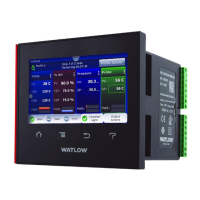Watlow F4T • 132 • Chapter 5 Function Reference
Input Dry Contact
Use this function to integrate a signal from a switch or contact in a field I/O device into the
application. For example, use a dry contact to detect the state of a door switch connected to
a digital I/O point on the controller.
This FB is found on the canvas of the FB diagram. The number of these FBs that are available
depends on the number of digital I/O flex modules installed and configured as dry contact in-
puts.
Signals
Direction Label Type Function
Transmitter - - - - Digital
Transmitter is inactive (off) when measured resistance is
greater than 100KΩ and active (on) when less than 50Ω
Name
Uniquely identify this FB using up to 20 alphanumeric characters.
Direction
To configure the I/O point to detect a contact closure, set Direction to Input Dry Contact.
Output
Use this function to switch an external device. This FB is found on the canvas of the FB dia-
gram. The number of these FBs that are available depends on the number of digital I/O flex
modules installed and configured as outputs.
Signals
Direction Label Type Function
Receiver - - - -
Analog
(%)
or Digital
Off or 0%: the output is off.
Between 0% and 100%: the output switches according to
the Time Base Type setting.
On or 100%: the output is on.
Name
Uniquely identify this FB using up to 20 alphanumeric characters.
Direction
To configure the I/O point to drive the physical output, set Direction to Output.
Time Base Type
Choose the method used to operate the output when the input is an analog percentage. With
either of the methods, the output switches off and on such that the average amount of time
the output is on equals the desired percentage.
Note:
The type of field device connected to the output determines how frequently it can be
switched.
Options:
• Fixed Time Base: the percent output power is converted to a duty cycle over the Fixed

